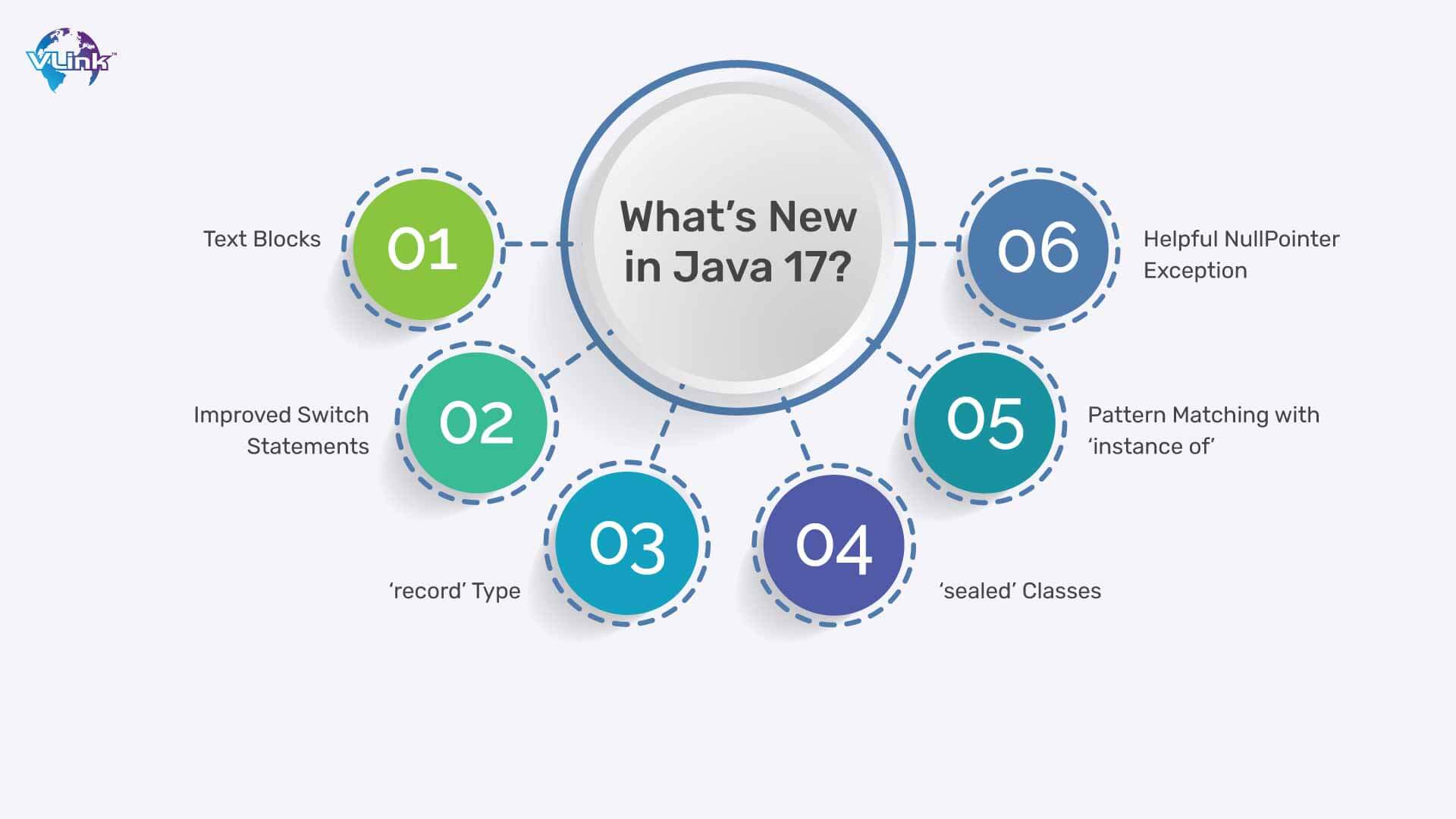In the ever-evolving landscape of programming languages, Java stands strong as one of the most used and versatile languages. Java 17 promises stability and longevity for Java developers. With many new features and enhancements, this latest version is known to streamline coding, improve performance, and enhance the overall developer experience.
This blog will explore the latest features and enhancements of the Java 17 version.
Why Should You Move Towards Java 17?
 Here are several benefits why you should move toward the Java 17 version for web app development:
Here are several benefits why you should move toward the Java 17 version for web app development:
Performance Improvements
Java 17 may introduce performance enhancements and optimizations, making your applications run faster and more efficiently than older versions.
Security Updates
With each new version, Java typically addresses security vulnerabilities in previous releases. Upgrading to Java 17 ensures that your applications have the latest security patches, reducing the risk of security breaches.
Language Enhancements
Java 17 may introduce new language features, APIs, and libraries that improve developer productivity and enable the creation of more robust and maintainable code.
Long-Term Support (LTS)
Java 17 is likely to be designated as a Long-Term Support (LTS) release, meaning it will receive updates and support for an extended period, typically several years. This stability is crucial for enterprise applications that require long-term maintenance and support.
Compatibility and Stability
Java 17 is designed to be backward-compatible with older versions of Java, ensuring that existing applications can be easily migrated without significant code changes. As an LTS release, Java 17 prioritizes stability, providing a reliable platform for mission-critical web and mobile application development solutions.
Tooling Support
The Java ecosystem prioritizes support for the latest Java versions, including Java libraries, IDEs, build tools, and frameworks. Upgrading to Java 17 ensures compatibility with the latest tooling and libraries, enabling developers to take advantage of the latest advancements in the Java ecosystem.
Community and Industry Adoption
As newer versions of Java gain traction and adoption within the development community and industry, staying up-to-date with the latest releases ensures that your dedicated development team remains competitive and benefits from the collective knowledge and experience of the broader Java community.
What's New in Java 17? Latest Features & Enhancements!

TextBlocks
Java has introduced text blocks to enhance code readability and eliminate the need for excessive string formatting. With text blocks, developers can enclose their text within triple quotes, including multiple double-quoted strings, without requiring escape characters.
An example is shown below:
private static void jsonBlock() {
String text = """
{
"name": "John Doe",
"age": 45,
"address": "Doe Street, 23, Java Town"
}
""";
System.out.println(text);
}
It's easy to write JSON and similar strings, which would require heavy usage of escape characters.
Improved Switch Statements
Switch Expressions in Java enable returning values from switch cases, facilitating their use in assignments and other contexts. Instead of using a colon (:), the arrow operator (->) is permitted to denote the return expression. The break keyword becomes unnecessary when returning from switch expressions, although a default case remains obligatory.
private static void improvedSwitch(Fruit fruit) {
String text = switch (fruit) {
case APPLE, PEAR -> {
System.out.println("the given fruit was: " + fruit);
yield "Common fruit";
}
case ORANGE, AVOCADO -> "Exotic fruit";
default -> "Undefined fruit";
};
System.out.println(text);
}
When multiple operations are performed within a switch case, it's possible to use a case block and indicate the return value using the yield keyword. It's important to note that the keyword yield is context-dependent, meaning it can be used as a variable name elsewhere within the function.
'Record' Type
Record classes represent a distinctive immutable class designed to supersede data transfer objects (DTOs). Typically, when incorporating a plain old Java object (POJO) within our class or methods, we must declare the class while specifying all the getters, setters, equals, and hashcode functions.
'Sealed' Classes
Sealed classes offer enhanced control over the inheritance hierarchy by specifying which classes can extend them. In Java 11, a class can either be final or extendable. To regulate which classes can extend a superclass, one could previously place all courses in the same package and grant package visibility to the superclass. However, this approach restricts access to the superclass from outside the package.
Pattern Matching with 'instance of'
In Java 11, it's common practice to utilize the instanceof operator to determine if an object belongs to a specific class. Upon confirming the object's class membership, explicit casting is typically required to execute operations on it. Here's an example:
private static void oldStyle() {
Object o = new Grape(Color.BLUE, 2);
if (o instanceof GrapeClass) {
Grape grape = (Grape) o;
System.out.println("This grape has " + grape.getPits() + " pits.");
}
}
Previously, explicit casting to type Grape was necessary to determine the number of pits. However, with Java 17, we can update this to:
private static void patternMatchingInJava17() {
Object o = new Grape(Color.BLUE, 2);
if (o instanceof Grape grape) {
System.out.println("This grape has " + grape.getPits() + " pits.");
}
}
We can combine the instanceof check with an && (and) condition, but not || (or), because in the case of an "or" condition, the statement could proceed to evaluate the other condition even if the instanceof check returns false.
The variable grape's scope can even extend beyond the if block if the instanceof check returns true. In the provided example, a RuntimeException will be thrown if the object is not of type Grape, thus the compiler will ensure the existence of the grape object when it reaches the print statement. Further details on pattern matching with instanceof can be found here.
private static void patternMatchingScopeException() {
Object o = new Grape(Color.BLUE, 2);
if (!(o instanceof Grape grape)) {
throw new RuntimeException();
}
System.out.println("This grape has " + grape.getPits() + " pits.");
}
Helpful NullPointerException
In Java 11, when encountering a NullPointerException, only the line number where the exception occurred is provided without indicating the specific method or variable that resulted in the null value. However, Java 17 has enhanced this messaging by including the exact method invocation responsible for triggering the NullPointerException in the error message.
public static void main(String[] args) {
HashMap<String, Grape> grapes = new HashMap<>();
grapes.put("grape1", new GrapeClass(Color.BLUE, 2));
grapes.put("grape2", new GrapeClass(Color.white, 4));
grapes.put("grape3", null);
var color = ((Grape) grapes.get("grape3")).getColor();
}
Performance Benchmarks
Java 17 has demonstrated improvements over Java 11 in terms of both memory usage and time complexity. Benchmark tests compared code performance between the two versions across various tasks. General findings include:
- Java 17 exhibits an 8.66% speed increase over Java 11 and a 2.41% improvement over Java 16 when using the G1GC (default garbage collector).
- With the ParallelGC (Parallel Garbage Collector), Java 17 is 6.54% faster than Java 11 and 0.37% faster than Java 16.
- The Parallel Garbage Collector, introduced in Java 17, shows a notable 16.39% speed enhancement compared to the G1 Garbage Collector utilized in Java 11.
If you are looking for experienced Java developers specialized in Java 17, hire developers at VLink!
Hire Java Developers Experts in Java 17 Version from VLink!
At VLink, we have a dedicated Java developer team with in-depth knowledge and hands-on experience in Java 17. When you hire our developers, you build your Java projects with efficiency, scalability, and innovative technology.
Why Hire Java Developers from VLink?
- Expertise in Java 17
- Industry Experience
- Commitment to Quality
- Agile Development Methodology
- Continuous Learning
What Services Our Developers Have Expertise In?
- Custom Java Application Development
- Java 17 Migration and Upgradation
- Performance Optimization
- Maintenance and Support
For more information about Java developers, contact us!
Frequently Asked Questions
To hire Java developers within 48 hours, utilize multiple channels for sourcing candidates, such as job boards, social media, and developer communities. Clearly outline job requirements, offer competitive compensation, streamline the interview process, and utilize technical assessments to evaluate candidates' skills efficiently. Leverage recruitment agencies if necessary.
The latest Java versions were Java 17, Java 18, and Java 21. Java 17 introduced enhanced security, performance improvements, and sealed classes. Java 18 focused on enhanced pattern matching, vector API updates, and improved APIs for Stream and Optional. Always check for the latest updates for newer features.
Java 21 has many new capabilities that benefit the Java ecosystem, such as virtual threads, record patterns, and sequenced collections. It has fantastic features, including training templates, scoped values, and structured concurrency.














